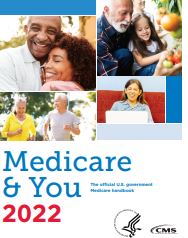Category: News
Medicare: Who Pays First?
How to Create a “My Social Security Account” in 2022
Applying for Medicare Part A & Part B Online
Signing up for Medicare Part A & Part B online is the fastest way to sign up.
You will need to create or sign in to an existing My Social Security account to sign up for Medicare electronically.
Please refer to the Checklist for Online Medicare, Retirement, & Spouses Applications to make sure you have all the information required to complete the online Medicare application.
Depending on your situation, the application process may take between 10 to 30 minutes to complete.
You can save your application as you go and come back to it later.
A representative may contact you with updates regarding your application once submitted.
You may also check the status of your application by signing onto your My Social Security account.
2023 Inflation Adjustment Amounts for HSAs
The IRS released the inflation adjustments for health savings accounts and their accompanying high deductible health plans effective for calendar year 2023, and the maximum amount that may be made newly available for excepted benefit health reimbursement arrangements. All limits have increased from the 2022 amounts.
The IRS released the inflation adjustments for health savings accounts (“HSAs”) and their accompanying high deductible health plans (“HDHPs”) effective for calendar year 2023, and the maximum amount that may be made newly available for excepted benefit health reimbursement arrangements (“HRAs”). All limits have increased from the 2022 amounts, some significantly.
For the Bulletin, see Rev. Proc. 2022-24, April 29, 2021, https://www.irs.gov/pub/irs-drop/rp-22-24.pdf.
Annual Contribution Limitation
For calendar year 2023, the limitation on deductions for an individual with self-only coverage under a high deductible health plan is $3,850; the limitation on deductions for an individual with family coverage under a high deductible health plan is $7,750.
High Deductible Health Plan
For calendar year 2023, a “high deductible health plan” is defined as a health plan with an annual deductible that is not less than $1,500 for self-only coverage or $3,000 for family coverage, and the annual out-of-pocket expenses (deductibles, co-payments, and other amounts, but not premiums) do not exceed $7,500 for self-only coverage or $15,000 for family coverage.
Non-calendar year plans: In cases where the HDHP renewal date is after the beginning of the calendar year (i.e., a fiscal year HDHP), any required changes to the annual deductible or out-of-pocket maximum may be implemented as of the next renewal date. See IRS Notice 2004-50, 2004-33 I.R.B. 196, Q/A-86 (Aug.16, 2004).
Catch-up Contribution
Individuals who are age 55 or older and covered by a qualified high deductible health plan may make additional catch-up contributions each year until they enroll in Medicare. The additional contribution, as outlined by the statute, is $1,000 for 2009 and thereafter.
Excepted Benefit HRA Adjustment
For plan years beginning in 2023, the maximum amount for an excepted benefit HRA that may be made newly available for the plan year is $1,950.
Proposed Regulations to Fix ACA’s Affordability “Family Glitch”
The Treasury Department and the Internal Revenue Service (“IRS”) recently proposed regulations that would expand the availability of premium tax credits in the Marketplace. For purposes of eligibility for a premium tax credit, the proposed rule provides that:
- Affordability of employer-sponsored coverage for family members would be determined based on the employee’s cost to cover the employee and the family members.
- The determination of whether employer-sponsored coverage for family members provides minimum value would be based on the family coverage.
If finalized in their current form, the proposed rules are expected to take effect in the 2023 tax year.
While these proposed changes would not affect the affordability determination for purposes of the Affordable Care Act’s (“ACA”) employer mandate, they would indirectly impact employer plans as more family members may qualify for premium tax credits and choose to enroll in coverage through the Marketplace.
Background
Under the current rules, individuals are not eligible for premium tax credits in the Marketplace if they are offered employer-sponsored group health plan coverage that is “affordable” and provides minimum value. For this purpose, employer-sponsored coverage is considered “affordable” if an employee is not required to pay more than 9.5% of household income for self-only coverage (9.61% for 2022 – the applicable percentage for 2023 has not yet been announced). If this is the case, then the coverage is considered affordable for both the employee and the employee’s family members, regardless of how much the employee must pay to cover those family members. This is known as the “family glitch.”
An employer-sponsored plan provides minimum value if the plan’s share of the total allowed cost of benefits provided is at least 60%. Under current rules, as long as self-only coverage offered by an employer provides minimum value to an employee, then coverage offered to the employee’s family members is also considered to provide minimum value.
Proposed Rule
Affordability
The proposed rule would refine the definition of affordable coverage to make it easier for family members to qualify for premium tax credits. Employer-sponsored coverage would be considered affordable for family members (thereby disqualifying them from eligibility for premium tax credits) only if the portion of the annual premium the employee must pay for family coverage does not exceed 9.5% of household income (as indexed).
As a result, when assessing whether an individual has received an affordable offer of employer-sponsored coverage, the Marketplace would look separately at the employee’s cost of self-only coverage (to determine the employee’s eligibility for premium tax credits), and at the employee’s cost to cover the family (to determine the family members’ eligibility for premium tax credits). There will likely be scenarios where an employee has an offer of self-only coverage that is affordable, but the offer of coverage to the family members is considered unaffordable (thus potentially qualifying those family members for premium tax credits).
For this purpose, family coverage means all employer plans that cover any related individual other than the employee, including a self-plus-one plan for an employee enrolling one other family member in the coverage. The proposed rule details scenarios that may arise to determine whether employer coverage is affordable, including situations where an individual has offers of coverage from multiple employers or where covered family members are not part of the employee’s tax family (e.g., a non-tax dependent child, or a spouse filing separately).
Minimum Value
The proposed rule would also amend the premium tax credit eligibility rules related to minimum value. An employer-sponsored plan would be considered to provide minimum value for family members if the plan’s share of the total allowed costs of benefits provided to family members is at least 60%, and the plan includes substantial coverage of inpatient hospital services and physician services.
Employer Action
The proposed rule does not impact the determination of whether employer-sponsored coverage is affordable for purposes of avoiding a shared responsibility penalty under the ACA’s employer mandate. Whether coverage is affordable for this purpose continues to be based solely on the cost of self-only coverage in the lowest-cost plan that provides minimum value.
However, should the rule take effect as currently written, employers may see employees more closely evaluate options for family members in the Marketplace. Employees may find Marketplace coverage more cost effective than the employer plan and move their family members off the group health plan coverage.
Further, it is possible the Form 1095-C will be revised with new offers of coverage codes, since the IRS will need to understand whether affordable and minimum value offers of coverage were made to family members who otherwise may obtain a premium tax credit in the Marketplace.
This document is designed to highlight various employee benefit matters of general interest to our readers. It is not intended to interpret laws or regulations, or to address specific client situations. You should not act or rely on any information contained herein without seeking the advice of an attorney or tax professional.
Virginia Aligns Overtime Pay Laws with FLSA
On April 11, 2022, Virginia amended its overtime wage laws to follow federal overtime pay provisions set by the federal Fair Labor Standards Act (FLSA). The amendments become effective July 1, 2022.
Nebraska Simplifies Youth Employment Certificate Process
On April 20, 2022, Nebraska amended its child labor laws to streamline the process for approving youth employment certificates. The amended provisions become effective on July 19, 2022.
Tennessee Amends Work Authorization Verification Requirements
On April 19, 2022, Tennessee adopted House Bill (HB) 1853 and amended some of the state’s requirements for employer use of E-Verify (the federal government’s online system for employment authorization verification). The amendments became effective on the same date they were adopted.
Imperial Coverage can help you take a deep dive into Medicare and replace confusion with confidence
As you get older, you’ll need to make decisions about everything from retirement investments to the right kind of health insurance. These decisions can be complicated and time consuming. Medicare in particular can be challenging to deliberate. Should you choose a traditional (original Medicare) plan or go with a Medicare Supplement or Medicare Advantage plan? And how much coverage should you have when it comes to prescription medication? These and other questions may seem frustrating and overwhelming. But rest assured, choosing a Medicare plan can be accomplished with appropriate assistance.
Whether you are about to turn 65 and need some information, or you’ve been considering a change in your current Medicare plan, our friendly, patient and knowledgeable team can provide valuable information to help you make a more confident decision. Please do not hesitate to contact us. We can assist clients in any state.
As an added value, our Elder Care Attorney focuses on elder law trusts, estate planning, planned giving, long-term care, special needs planning, and asset preservation. His experience includes drafting wills and trusts from the straightforward to the complex, as well as the complicated process of preparing and steering Medicaid applications through the appropriate government and social service agencies. He also advises clients on business succession and tax planning issues.




